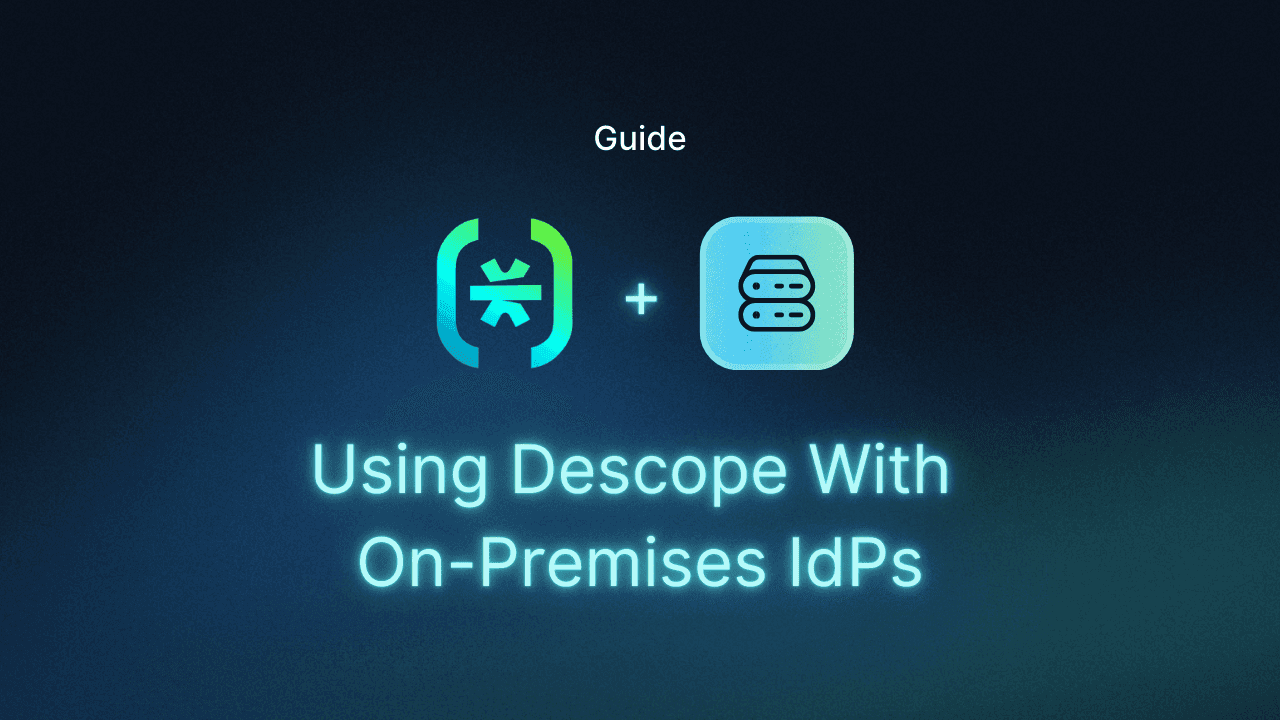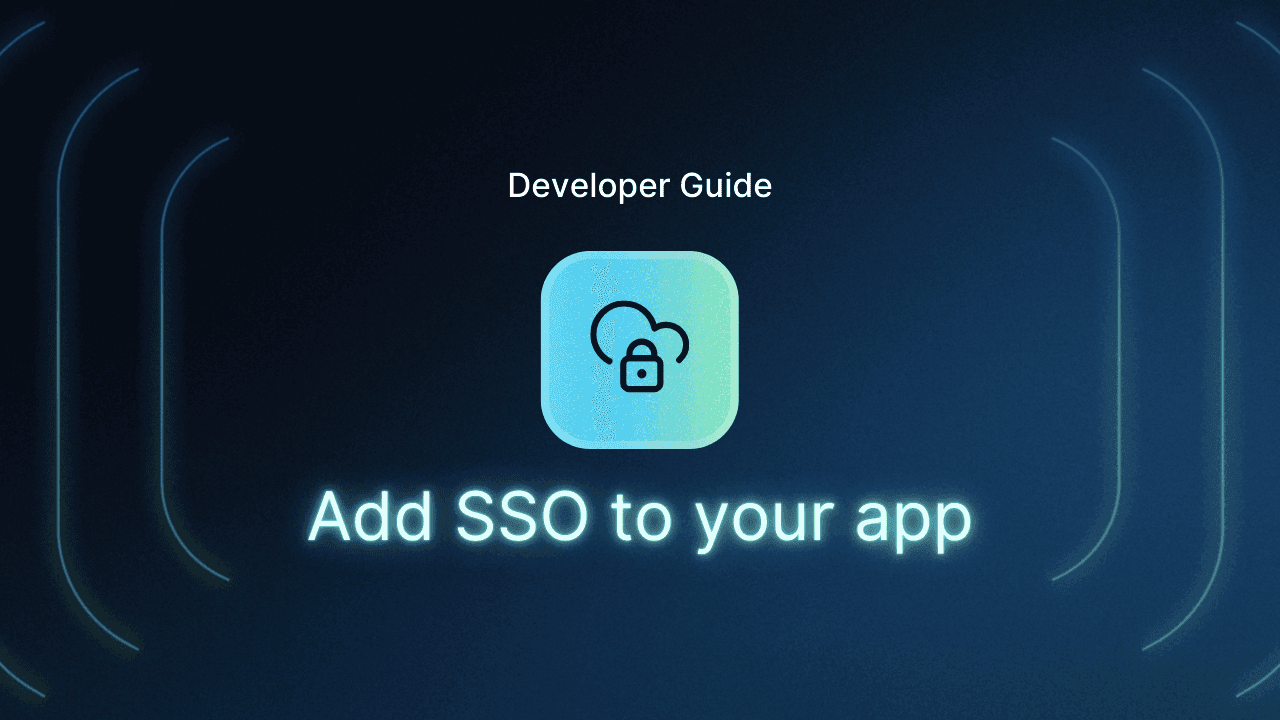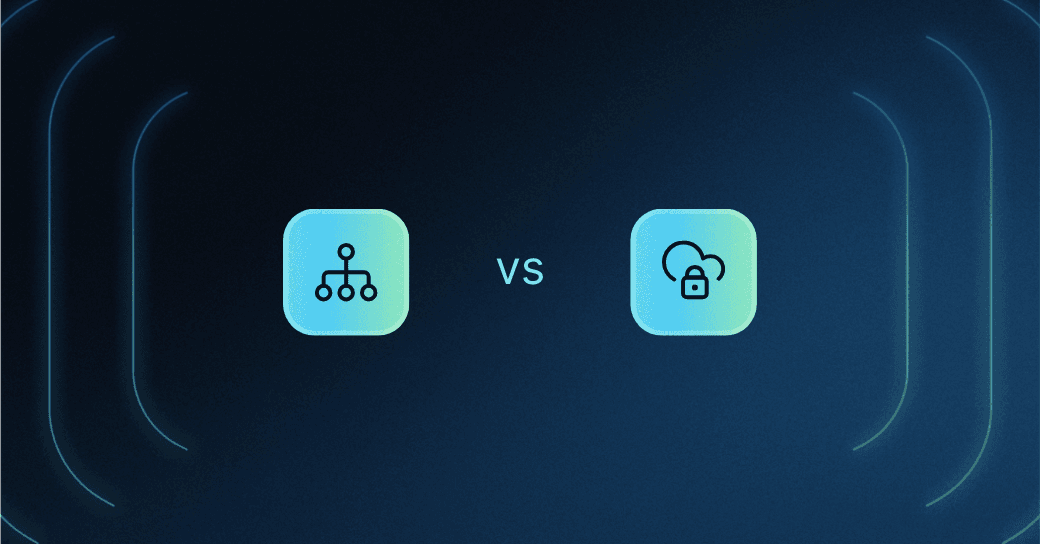Table of Contents
Key deployment considerations
As more enterprises adopt hybrid and private cloud deployment strategies, it’s increasingly common for SaaS companies to offer on-premises versions of their applications. These apps must still support enterprise-grade features like SSO, MFA, user provisioning, and audit trails—all without compromising security or usability.
Descope is uniquely positioned to support such scenarios, providing a flexible identity platform that works equally well in the cloud and within customer-hosted environments.
This guide explores how to integrate Descope into an on-premises or hybrid environment, with recommendations on secure communication, network configuration, and common deployment patterns.
Key deployment considerations
When deploying an app to a customer’s data center or private VPC, you’ll need to:
Isolate credentials: Use a static API key per customer/project
Ensure connectivity: Allow your customer’s environment to communicate with Descope APIs
Support secure redirects: For authentication flows, SSO, or webhook-based events
Integrate with customer-managed IdPs: Especially when using SAML or OIDC-based SSO with local infrastructure like ADFS
Using a static Descope Project key
Each customer deployment should have its own dedicated Descope project and API key. This ensures:
Clean isolation between customer data
Easy revocation and rotation of keys
Better auditing and operational control
Follow these steps to set up your Descope Project key:
Log in to the Descope Console
Create a new Project per on-prem customer
Navigate to Project Settings > API Keys
Securely distribute the
Project ID,Public Key, andManagement Keyto your customer environmentConfigure these as environment variables or in your app’s secrets manager
💡 You can also create separate tenants within a project to support multi-org logic inside a single customer deployment.
Enabling network access to Descope
To enable Descope features such as SSO, MFA, hosted authentication Flows, and webhooks in an on-premises environment, the deployed application must be able to communicate with the Descope cloud platform.
Depending on your customer’s network posture, there are two primary strategies to establish this connectivity:
Strategy 1: Configure firewall rules and ACLs to allow direct traffic to/from Descope
Strategy 2: Use a reverse proxy tunnel (e.g., ngrok or Cloudflare Tunnel) to establish secure connectivity without modifying firewall rules
Strategy 1: Configure firewall rules or ACLs
This is the preferred approach for production environments where stable, direct communication is required.
Descope endpoints to allow
Endpoint | Purpose |
|---|---|
https://api.descope.com | Descope APIs: authentication, user/session management |
https://static.descope.com | Hosted Flows, JavaScript SDK, web components |
Ingress rules (incoming traffic to customer environment)
Some Descope features require initiating HTTP(S) requests from Descope to the on-premises application. These include:
SSO and OAuth redirect responses
Hosted Flow redirect responses
Webhook notifications (e.g., login events, step-up MFA success)
To support these use cases:
Allow inbound HTTPS traffic on port 443
Restrict access to known callback or webhook routes such as:
https://your-customer-app.com/callbackhttps://your-customer-app.com/descope/webhook
(Optional) Use IP-based allowlisting. Descope routes all outbound traffic through Cloudflare’s published IP ranges. Customers can restrict ingress to these IPs for enhanced security.
Egress rules (outgoing traffic from customer environment)
The on-premises application must initiate secure requests to Descope for operations such as:
Session validation
Authentication API calls
Retrieving hosted Flow assets
To support these:
Allow outbound HTTPS traffic on port 443
Permit access to:
https://api.descope.comhttps://static.descope.com
Ensure DNS resolution is enabled for both domains
If an outbound proxy is used, ensure TLS inspection does not interfere with certificate validation or SDK behavior
Strategy 2: Use a reverse proxy tunnel (e.g., ngrok or Cloudflare Tunnel)
This approach is ideal when the customer cannot or does not want to modify firewall rules. A secure tunnel exposes specific local ports or paths to the internet, enabling Descope to send requests as needed.
No changes required to the customer’s firewall or ACLs
Suitable for testing, proof-of-concept deployments, and high-security environments
Allows secure HTTPS-based communication for authentication and event delivery
ngrok setup guide
Step 1: Install ngrok
Download and install the ngrok CLI:
macOS/Linux (via Homebrew):
brew install ngrok/ngrok/ngrokWindows: Download the installer from https://ngrok.com/download
Step 2: Authenticate (recommended for reserved domains)
If you have a paid ngrok plan and want to use static subdomains or additional access control:
ngrok config add-authtoken <your-ngrok-token>Step 3: Start the tunnel
Assuming your application is running locally on port 3000:
ngrok http 3000This will generate a temporary HTTPS URL such as:
Forwarding https://brisk-horse.ngrok.io → http://localhost:3000Step 4: Configure Descope
In the Descope Console:
Set your redirect and webhook URLs to use the ngrok domain:
https://brisk-horse.ngrok.io/callbackhttps://brisk-horse.ngrok.io/descope/webhook
This ensures Descope can successfully return authentication responses and deliver events to the on-premises application.
Cloudflare Tunnel setup (alternative)
If your customer already uses Cloudflare or prefers a corporate-grade tunneling service:
Step 1: Install cloudflared
Instructions: Cloudflare Tunnel Installation Guide
Step 2: Authenticate and create a tunnel
cloudflared tunnel login
cloudflared tunnel create descope-tunnelStep 3: Configure routing and DNS
cloudflared tunnel route dns descope-tunnel login.customer-domain.comStep 4: Start the tunnel
cloudflared tunnel run descope-tunnelStep 5: Configure Descope
Use the public domain (e.g., https://login.customer-domain.com/callback) in your Descope SSO and webhook configuration.
Security considerations for Tunnels
Ensure your ngrok or Cloudflare Tunnel configuration includes basic auth, access control, or IP restrictions
Use persistent URLs (available in paid plans) for production environments
Monitor tunnel uptime and reconnect if interrupted
Validate certificates and ensure TLS is enabled
Summary: Choosing between the two approaches
Feature | Firewall Rules (Strategy 1) | Reverse Tunnel (Strategy 2) |
|---|---|---|
Best for Production | Yes | No (unless using paid plan) |
Minimal IT Involvement | No | Yes |
Custom Domain Support | Yes | Yes |
Persistent URLs | Yes | Only with paid plans |
Secure HTTPS Communication | Yes | Yes |
Supports Webhooks & Redirects | Yes | Yes |
Deployment Complexity | Moderate | Low |
Example: Embedded admin dashboard for healthcare SaaS
A B2B healthcare platform offers an on-premises deployment of their admin dashboard to hospitals with strict compliance requirements. The deployment:
Lives within a hospital-managed AWS VPC
Uses ADFS for employee authentication
Requires SSO with SAML and step-up MFA
Must allow login redirect and webhook events
Here's how the Descope integration works:
A dedicated Descope Project with SAML SSO configured via the SSO Setup Suite
A static redirect URL configured via a secure tunnel with a domain like
hospital-ngrok.ioEgress rules allowing access to
api.descope.comLogin flow triggers MFA via Descope Flows, even though the IdP is on-premises
This setup enabled full compliance with internal IT policies while allowing Descope to manage authentication seamlessly.
Air-gapped environments
Fully isolated or air-gapped environments—such as those in defense, finance, or government—do not allow any internet access. In these cases, cloud-based identity services like Descope cannot be directly used.
Recommended dual strategy:
For connected environments: Continue using Descope for SSO, MFA, and Flows
For air-gapped deployments:
Build a lightweight plugin that mimics Descope’s JWT issuance locally
Use internal IdPs (e.g., Active Directory) with your own auth logic
Mirror your Descope integration patterns (e.g., claims, roles, sessions) to maintain application consistency
Though not directly connected, this hybrid model allows your app to maintain a uniform experience across deployments while satisfying even the most stringent network restrictions.
Connecting to on-premises identity providers (e.g., ADFS)
Descope supports IdP-initiated and SP-initiated SSO via both SAML and OIDC, making it easy to connect with common on-premises identity providers like:
Microsoft ADFS
PingFederate
ForgeRock
Shibboleth
Keycloak in on-premises mode
To set this up, use the SSO Setup Suite in the Descope Console, which provides a step-by-step guided configuration flow to:
Upload or fetch IdP metadata
Set ACS / Redirect URIs
Configure attribute mappings (email, name, groups, etc.)
Test and verify the SSO connection securely
💡 Descope supports both tenant-specific and project-wide SSO connections—ideal for multi-tenant SaaS platforms.
Securing complex enterprise environments with Descope
Descope brings flexible, modern B2B CIAM to even the most technically demanding enterprise scenarios. With built-in support for SSO, MFA, device security, and webhook-driven flows, you can confidently deploy your product into customer-owned infrastructure without sacrificing security or developer experience.
For help getting started with on-premises deployments, reach out to our support team or explore our documentation.






